Author: Christine Kim, Galaxy
Translation: Bai Shui, Golden Finance
Overview
More than 50 non-crypto companies are building products and services on Ethereum or Ethereum L2. These companies include fashion brands like Louis Vuitton and Adidas, as well as financial institutions like Deutsche Bank and PayPal. These products and services clearly do not include those related to general market infrastructure such as cryptocurrency trading, custody, auditing, and compliance. Instead, they are related to crypto-specific infrastructure and use cases, such as NFTs, RWAs, Web3 developer tools, and L2s. Among the 20 financial institutions that have established crypto-specific infrastructure and applications, 10 are banks, most of which issue RWAs on Ethereum. This report aims to highlight the early and primary use cases of Ethereum by traditional companies and institutions.
Introduction
For the purposes of this report, the main sectors of the crypto industry can be divided into three categories:
General Infrastructure – Companies that provide products and services related to cryptocurrencies and blockchain that are not exclusive to the crypto industry, such as general market infrastructure (i.e., exchanges, market makers, asset management) and general business support (i.e., banking, accounting, consulting, compliance).
Crypto-Specific Infrastructure – Companies that provide products and services that are unique and exclusive to crypto. For example, this includes companies involved in mining, staking, and building on-chain oracles, which are responsible for infrastructure that is only useful in crypto and blockchain environments.
Crypto Use Cases and Applications – Companies that are building consumer applications that run entirely or partially on the blockchain. For example, decentralized exchanges automatically execute cryptocurrency trades on the blockchain without relying on third-party intermediaries.
Traditional companies are not expanding their existing applications and service suites to support cryptocurrencies; instead, they are innovating new products and services that can only be supported by blockchain. Additionally, many of these companies (at least 55) are innovating on public blockchains like Ethereum and Ethereum L2s such as Polygon, Arbitrum, and Base.
Below is a market map of 55 non-crypto native companies that have built or are building crypto-specific infrastructure and applications on Ethereum and Ethereum L2.
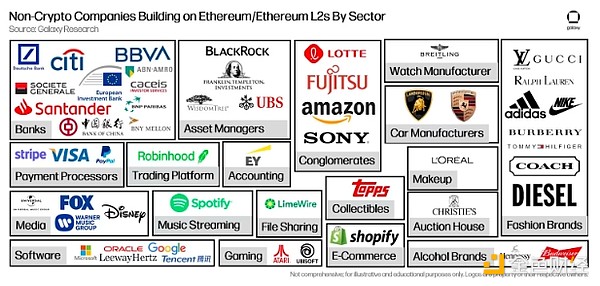
Among these 55 companies, at least 23 have issued NFTs on Ethereum or Ethereum L2.
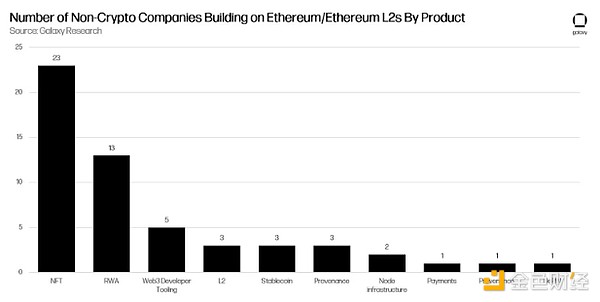
While most companies are building directly on Ethereum, at least 17 companies have already attempted or are trying to build across multiple general blockchains and Layer-2 Rollups.
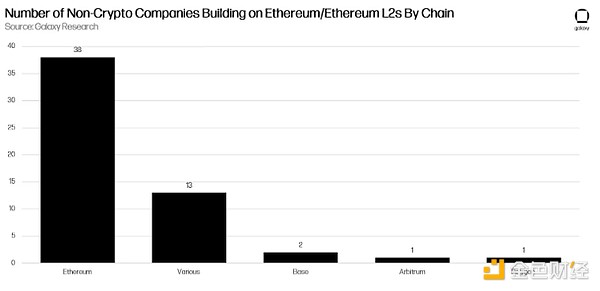
RWAs on Ethereum
One of the most common types of non-crypto companies in the Ethereum ecosystem is financial institutions, such as banks, asset management firms, payment processors, trading platforms, and accounting firms. Among the 20 financial institutions identified as having built crypto-specific infrastructure and applications, 13 have issued RWAs on Ethereum and Ethereum L2. The types of RWAs issued on-chain include money market funds (like Franklin OnChain U.S. Government Money Fund) and government bonds issued by entities like the European Investment Bank.
Ethereum is the preferred blockchain for issuing tokenized assets, with a total value of RWAs nearly ten times that of the next most popular RWA blockchain, Stellar. ZKsync, a Layer-2 rollup built on Ethereum, has a higher number and total value of RWAs issued on-chain than Stellar. Six of the top ten protocols issuing RWAs are on Ethereum or Ethereum L2.
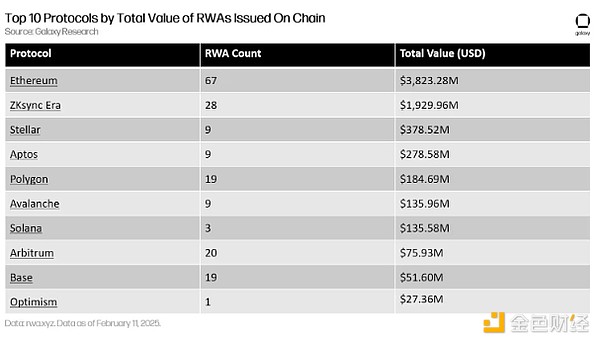
As of February 11, 2025, the third-largest tokenized fund across all blockchains is BlackRock's U.S. Dollar Institutional Digital Liquidity Fund (BUIDL). Launched in March 2024, BUIDL offers investors dollar returns with the advantages of instant transparent settlement and interoperability between traditional financial markets and decentralized financial markets. Robert Mitchnick, BlackRock's head of digital assets, stated in March: "Through tokenization, we are exposing traditional financial investment risk to a crypto-native wrapper."
The world's largest asset management company, BlackRock, partnered with tokenization platform Securitize and U.S. financial services company BNY Mellon to launch BUIDL on Ethereum for the first time. Since March of last year, BlackRock has expanded the fund to five additional protocols beyond Ethereum, three of which are Ethereum L2s.
The value of RWAs issued solely on Ethereum has doubled over the past year. According to data from rwa.xyz, over 160 RWAs have been issued on Ethereum and are held in 60,000 unique active wallet addresses. These numbers do not include stablecoins.
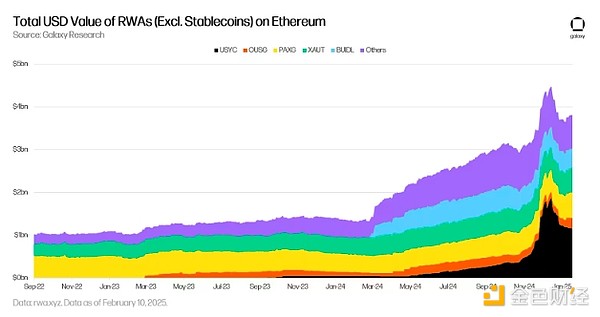
Despite being fewer in number, a subset of financial institutions dedicated to RWAs and tokenization is also developing their own stablecoins. Payment processor PayPal launched its dollar-pegged stablecoin PYUSD on Ethereum for the first time in August 2023. Since then, PayPal has expanded the issuance of PYUSD to Solana. Trading platform Robinhood, in collaboration with numerous other crypto-native institutions such as Galaxy Digital, Kraken, Nuvei, Anchorage, Bullish, and Paxos, is also set to launch its own dollar-pegged stablecoin USDG on Ethereum in November 2024.
The total circulating supply of stablecoins on Ethereum has increased by 70% over the past year. The collateral compositions and design types of these stablecoins vary, but the vast majority are dollar-pegged instruments that hold high-quality liquid assets (HQLA) as collateral. As of February 11, 2025, Ethereum accounts for over 50% of the total stablecoin market.
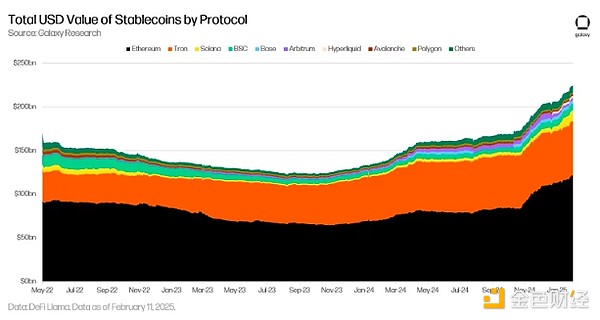
Data from Galaxy Research indicates that by 2025, the total supply of stablecoins will double, exceeding $400 billion. A catalyst for the accelerated launch of new stablecoins supported by traditional financial partners this year was Stripe's acquisition of the stablecoin payment platform Bridge for $1 billion in 2024. Regarding this acquisition, Stripe CEO Patrick Collison stated: "Stablecoins are the room-temperature superconductors of financial services. Thanks to stablecoins, global enterprises will benefit from significant improvements in speed, reach, and cost in the coming years."
In the U.S., another catalyst for the adoption of RWAs and stablecoins is the regulatory environment. On February 4, 2025, SEC Commissioner Hester Peirce issued a statement outlining specific priorities and themes the commission may address concerning the digital asset industry, with the ninth item on her list emphasizing the modernization of traditional finance through tokenization. "The working group also plans to explore the intersection of cryptocurrencies with clearinghouse and transfer agent rules. We will continue to work with market participants who intend to tokenize securities or otherwise use blockchain technology to modernize traditional financial markets," the statement read.
RWAs and stablecoins are crypto-native use cases that are rapidly finding product-market fit within traditional financial institutions. As the most decentralized, widely covered by crypto-native users, and longest-running general blockchain, Ethereum serves as a gateway for many institutions to incubate and launch finance-focused cryptocurrency services and products.
Scalable Blockchain Infrastructure
Although Ethereum is the gateway for many financial institutions and non-crypto companies to leverage cryptocurrency and blockchain technology, it is not the protocol where new blockchain use cases can scale. Compared to blockchains like Solana, Ethereum has poorer performance, slower block times, and higher transaction fees. Ethereum protocol developers are committed to making Ethereum the center of Layer-2 rollups without sacrificing the network's resilience and security (a byproduct of network decentralization). Rollups are blockchain infrastructures that can inherit Ethereum's security and scale to millions of new users.
Non-crypto companies are not only advancing crypto use cases (like tokenization) on Ethereum but are also investing in the necessary infrastructure to support these use cases, making their audience broader than just crypto-native users. Deutsche Bank, Germany's largest bank, is collaborating with the team at Matter Labs, which is building ZKSync rollups, to develop new rollups on Ethereum. The rollup, codenamed Project DAMA 2, is part of a broader initiative led by the Monetary Authority of Singapore (MAS) and 24 other global financial institutions to explore the use cases of public blockchains in global finance.
Deutsche Bank's primary motivation for L2 is to create scalable, auditable, transparent blockchain infrastructure that can interoperate with regulated platforms and financial services. "Institutions looking to build on-chain are increasingly choosing ZKSync for the ability to build in Web3 without compromise. ZKSync provides institutions with customizable architecture to build tailored solutions that achieve privacy, scalability, and interoperability with other private and public blockchains," said Alex Gluchowski, co-inventor of ZKSync, when discussing Deutsche Bank's motivation for L2.
Financial institutions like Deutsche Bank are developing scalable blockchain infrastructure that is also customizable and compliant with Ethereum's regional regulations. However, the appeal of scalable and customizable blockchain infrastructure is not limited to financial use cases.
Recently, the Japanese conglomerate Sony launched its own rollup on Ethereum using the OP technology stack. Their motivation for creating and operating their own general rollup is to support a broader ecosystem of gaming, finance, and entertainment applications. Regarding Sony's L2 Soneium, Jun Watanabe, chairman of Sony's Blockchain Solutions Lab, stated, "I believe it is very important for the Sony Group to develop comprehensive Web3 solutions based on blockchain, as the group engages in a wide range of businesses under the mission of 'filling the world with emotion through the power of creativity and technology.'"
Since the launch of Soneium, the protocol has faced strong opposition due to Sony's oversight of on-chain activities, particularly the issuance of memecoins, which has led to restrictions on token transfers and blacklisted addresses. While this incident has raised questions about the extent to which enterprises should have control over the rollups they build on permissionless infrastructures like Ethereum, it also highlights the commitment of one of the world's largest conglomerates to seek answers to these issues. By launching Soneium, Sony is investing in new digital experiences and applications on Ethereum, and the launch of rollups on Ethereum underscores the potential value of Ethereum's blockchain space and the scalable blockchain infrastructure built on it.
Gaming on Ethereum L2
NFTs are a primary use case for traditional companies, mainly luxury fashion brands like Louis Vuitton and Coach, as well as luxury car manufacturers like Porsche and Lamborghini. Most of the NFTs issued by these companies were minted between 2021 and 2023, during the peak of the NFT craze. Given the decline in NFT floor prices over the past few years, many companies are no longer actively issuing NFTs on Ethereum and Ethereum L2 as of 2025.
The few companies still actively issuing NFTs on Ethereum in 2025 are doing so in the context of game development, and almost entirely on Ethereum L2 rather than on Ethereum itself.
In July 2024, video game giant Atari deployed two classic arcade games, "Asteroids" and "Breakout," on the Ethereum Optimistic Rollup Base operated by Coinbase. By the end of August 2024, gamers could earn rewards, mint exclusive Atari NFTs, and redeem physical goods on Base. A few months after Atari's foray into on-chain gaming, in October 2024, Lamborghini announced a partnership with Web3 gaming company Animoca Brands to launch a digital collectibles platform called FastForWorld.
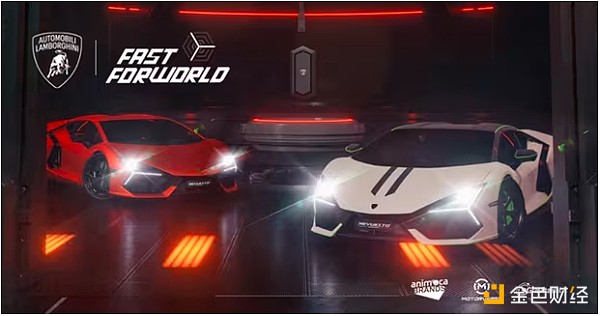
FastForWorld allows gamers to buy, sell, and drive Lamborghini cars in a series of games developed by Animoca Brands, including Torque Drift 2, REVV Racing, Motorverse Hub, and proprietary experiences from FastForWorld. The press release described this collaboration as "Lamborghini's first implementation of its iconic vehicles in gaming based on blockchain."
It was later revealed that in-game assets for FastForWorld would be minted on Base. The first version of the platform was launched on November 7, 2024, and is still actively being developed, with further expansions for the FastForWorld platform expected to be announced in 2025.
Recently, on January 7, 2025, one of South Korea's top five conglomerates, Lotte Group, announced a deeper partnership with the Arbitrum Foundation and Offchain Labs to build Lotte's metaverse gaming platform "Caliverse" on the Ethereum rollup Arbitrum. Caliverse, which is already live, allows users to shop, attend virtual concerts, and play games on its platform. "Together with the most trusted blockchain, Arbitrum, we are excited to take the first step into the blockchain world with Lotte Caliverse, leveraging Lotte's successful history in retail to provide excellent products and services to over 40 million people," said Kima Kim, CEO of Caliverse, when discussing the partnership with Arbitrum. During the 2025 Consumer Electronics Show (CES) held in Las Vegas, the Caliverse team announced plans to launch virtual reality and 3D movie features on its platform in the first half of 2025.
Notably, non-crypto native companies like Atari, Lamborghini, and Lotte's Caliverse are continuously investing in and developing NFTs, which are being developed in the context of larger on-chain gaming applications. Blockchain-based games may require frequent on-chain transactions, which can lead to expensive fees and network congestion. For this reason, these companies are building their games on Ethereum L2 to take advantage of the scalability benefits of Ethereum's rollup-centric architecture.
Steven Goldfeder, co-founder and CEO of Offchain Labs, stated, "Arbitrum's blockchain is the ideal home for Caliverse, thanks to its industry-leading 250-millisecond block time, enabling seamless virtual worlds and gaming use cases."
Conclusion
NFTs and RWAs are the primary use cases for Ethereum among non-crypto native companies and institutions. Among the companies issuing NFTs in the Ethereum ecosystem, the most active in 2025 are those issuing NFTs in on-chain gaming applications built on Ethereum L2. This highlights how the scalability benefits brought by L2 help support crypto-native use cases that require frequent on-chain interactions, such as gaming between major retail brands and companies. Ethereum's commitment to scaling its infrastructure through rollups also provides opportunities for early adopters of this technology in traditional finance and other sectors to lead non-speculative use cases in crypto by creating customizable and compliant infrastructure for these use cases. Finally, Ethereum remains the preferred blockchain for traditional financial companies issuing RWAs and stablecoins. Key partnerships and acquisitions established in 2024 are expected to drive new progress in stablecoin adoption in 2025.
免责声明:本文章仅代表作者个人观点,不代表本平台的立场和观点。本文章仅供信息分享,不构成对任何人的任何投资建议。用户与作者之间的任何争议,与本平台无关。如网页中刊载的文章或图片涉及侵权,请提供相关的权利证明和身份证明发送邮件到support@aicoin.com,本平台相关工作人员将会进行核查。




